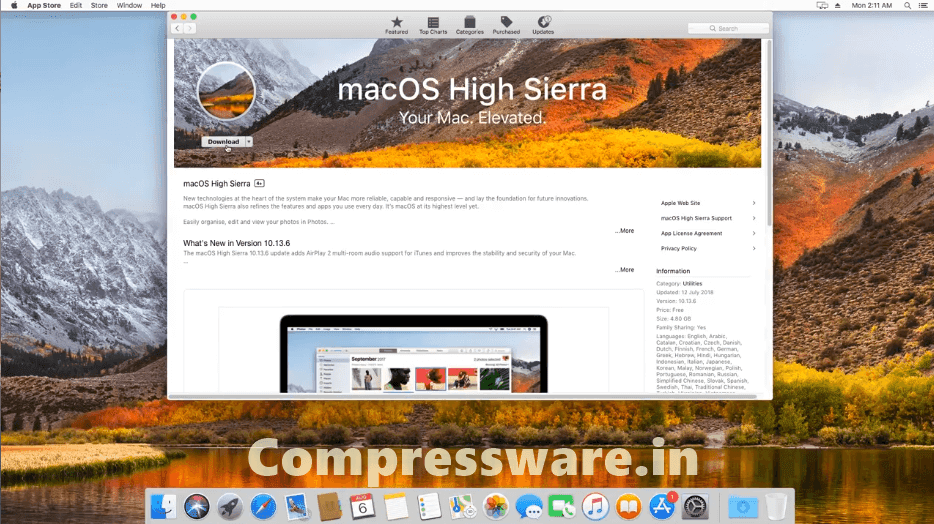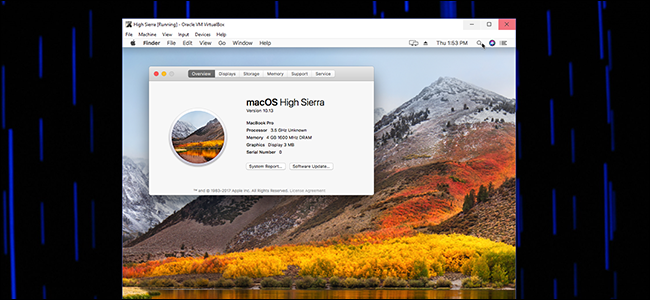It’s been 20 years since macOS X first arrived. Since then, there have been 15 different versions of OS X. Some were revolutionary, while others have stayed the course.
Running High Sierra on a 2017 4K iMac. Big Sur has not appeared in my Updates and when I tried from App Store, after clicking it showed “calculating “ for half an hour with only 1% showing. After a while that disappeared and there was no sign of downloading progress ( nothing when hover over. The history of macOS, Apple's current Mac operating system originally named Mac OS X until 2012 and then OS X until 2016, began with the company's project to replace its 'classic' Mac OS. That system, up to and including its final release Mac OS 9, was a direct descendant of the operating system Apple had used in its Macintosh computers since.
Stuck on UEFI interactive shell with Mac OS X High Sierra VM. Ask Question Asked 3 years, 7 months ago. MacOS X Catalina VM froze on boot.

Of course, the question for almost any Mac user is which version of OS X is best. Most machines are compatible with several versions, so you can choose.
Many people wonder about High Sierra vs Mojave. Mojave is the second-most recent version of OS X, and the last one to have support for 32-bit apps. High Sierra is the version before that, which builds on Sierra.
So, which is better? This guide will help you compare the two.
High Sierra vs Mojave
When it comes to macOS versions, Mojave and High Sierra are very comparable. The two have a lot in common, unlike Mojave and the more recent Catalina.
Like other updates to OS X, Mojave builds on what its predecessors have done. It refines Dark Mode, taking it further than High Sierra did. It also refines the Apple File System, or APFS, that Apple introduced with High Sierra.
APFS replaces the old Hierarchical File System (HFS+). It changes the way your computer organizes data. Apple had introduced it to mobile devices since it can help save space.
It also makes the process of copying files faster, among other things. True APFS functionality for fusion drives didn’t arrive until Mojave rolled out, though.
Another key difference between the two versions is support for 32-bit apps. With Mojave, Apple said they were no longer supporting 32-bit apps without compromise.
So, while a 32-bit app will still run on Mojave, it might act a bit strange. Functionality may be reduced or you may notice the app crashes a lot.
Still, Mojave will run 32-bit apps, unlike Catalina. If you want to keep running 32-bit apps without issue, though, High Sierra is your best bet. It supports 32-bit apps fully.
More Compatibility With iOS
Mojave continued the trend toward “iPadification.” More iOS apps made their way to macOS, as well as features.
High Sierra, for example, allows your Messages history to be kept in sync across devices. Mojave introduced a feature that allows you to choose your iPhone as a method of “content capture” while you’re working on your Mac.
Some iOS apps, like News, made their way to macOS with Mojave. If you’re using an older version of the OS, these apps won’t be available to you.
A True Dark Mode With Mojave
Dark Mode was first introduced in macOS El Capitan. Sierra called it “Night Shift.” High Sierra also included a Dark Mode, but users were less than impressed.
If you’re using Sierra or High Sierra, you can get more info about how to use Night Shift.

In High Sierra, the best you can get is a “dark” menu bar. Almost everything else remains bright. Even some of Apple’s own software defies dark mode and remains bright on the screen.
Mojave fixes this issue. Dark Mode now applies to every feature of every app, across the system. It’s truly a dark mode.
Many users like dark mode because it reduces eye strain. It’s particularly helpful for anyone who does a lot of work late at night or in a darkened room. Many users are familiar with dark mode from mobile apps, so they’ll be happy to see this option available.

Finder and Desktop Stacks
Other changes between High Sierra and macOS Mojave have to do with your desktop and the Finder. These features could help you stay a little more organized.
macOS Sierra had introduced Share Desktops, while Mojave introduces Desktop Stacks.
Mojave groups files, folders, and photos you drag onto your desktop. You’ll no longer need to hunt for a particular document. Instead, you can click on the relevant stack to see a list of files of that type.
Mojave also makes changes to Finder. It combines Quick Look and the Markup tools that first appeared back in 2014. You can now make changes to documents without even opening them.
Mojave also introduced Gallery View to Finder. It also makes screenshots work similar to iOS.
Which Is Better?
Mojave has some distinct advantages over High Sierra, but which one is really better? Choosing between macOS Mojave vs High Sierra depends on what you want to do with your Mac.
If you have a fusion drive, then Mojave is almost certainly the better bet for you. The refinements to APFS translate into a speedier computer and help you free up space.
If you’re a fan of dark mode, then you may well want to upgrade to Mojave. If you’re an iPhone or iPad user, then you may want to consider Mojave for the increased compatibility with iOS.
If you plan to run a lot of older programs that don’t have 64-bit versions, then High Sierra is probably the right choice. If you’re not concerned with integration between your iPhone and your Mac, then High Sierra could be the right choice.
Is Your Computer Compatible?
Before you decide to install either High Sierra or Mojave, you should make sure your computer is compatible.
Mojave will run on most Mac computers newer than 2012, with a few exceptions. MacBooks will need to be 2015 or newer, while iMac Pro computers will need to be 2017 or newer.
Mac Pro models from late 2013, mid-2012, and mid-2010 will also run Mojave. Most Macs from 2009 or 2010 will run High Sierra.
Get the Most out of Your Mac
If you’re not ready to make the leap to macOS Catalina, then Mojave or High Sierra could be the right choice. The winner of High Sierra vs Mojave depends on what features you want to see in your operating system.
As Apple keeps upgrading its OS, it’s bringing more apps to desktop platforms. Wondering if it’s a good idea to invest in a mobile app for your business? Discover how this and other tech can help you grow.
Related Posts
2 - 2
What are startup items?
Startup items, or login items, are services and applications that launch every time you start your Mac. These are applications that sneak into startup items without notice, never asking if you need or want them there. This way you may end up with a dozen apps launching as soon as you turn on your Mac, weighing heavily on its processor and memory capacities and slowing it down. Such items can increase your Mac’s startup time and decrease its performance.
Plus, sometimes when you remove an application or a service, it leaves a login item with a broken link. These broken login items are completely useless, cause unwanted messages, and waste your Mac's resources (because they look for non-existent applications). Whether you're running macOS Catalina or El Capitan, or earlier — it's all the same, so just read on.
So, let's go over how to take control of login items, and how to get rid of unwanted, broken or hidden startup items.
How to disable startup programs?
Do you want to stop programs from running at startup? There’s an easy way to remove programs from startup and get your Mac to load faster on launch. The fastest way to turn off startup items on Mac is an app like CleanMyMac X.
- Download CleanMyMac for free.
- Launch the app.
- Open Optimization tab.
- Click on Login items.
- From the list of apps, disable the ones you don’t need on startup.
- Done!
How to change startup programs manually?
Disabling Mac startup programs is possible manually. Therefore, if you have some time and would like to do it yourself, follow the steps below.
Your login items are listed in settings. One of the easiest ways to control startup items is inside System Preferences > Users & Groups.
- Open System Preferences.
- Go to Users & Groups.
- Choose your nickname on the left.
- Choose Login items tab.
- Check startup programs you want to remove.
- Press the “–” sign below.
- You’re done.
- If you need to add an item back, press “+” and choose the app you’d like add.
- Then restart your Mac to see the changes.
How to fix broken startup items?

Mac Os High Sierra Update To Catalina
Broken Mac startup files are left there because some part of apps are left on your Mac long after you’ve moved the app to the Trash. To get rid of these parts and to fix your startup, you’re going to need CleanMyMac again. First, you need to check if they’re among startup items and disable them if so. You can do it following the instructions above. Then you need to remove app leftovers. CleanMyMac works fine on macOS High Sierra and earlier OS.
- Launch CleanMyMac.
- Choose Uninstaller tab.
- Scroll through the list of apps.
- If you spot any app that you’ve deleted, check them.
- Delete the app leftovers you’ve chosen.
You can also find and remove broken login items with the help of System Junk module:
- Choose System Junk tab.
- Click Scan.
- Review details and click Clean.
Finally, you need to clean your macOS startup items through launch services:
Update From Mac Os High Sierra To Catalina
- Open Maintenance tab.
- Choose Rebuild Launch Services.
- Hit Run.
- Done.
Once you do it, all broken app data on your Mac will be fixed.
Upgrade Os High Sierra To Catalina
Remove daemons and agents from startup process
If speaking of files, first go to the system folder /Library/StartUpItems. Here you’ll find all the startup files that are being launched with the system. You can delete the login item you think is necessary if you’re totally sure what you are doing.
Also, the /Library/LaunchDaemons folder contains a bunch of preference files that define how the application that is being launched along with the system should work. You might want to delete some of these files as well if you know you don’t need them and removing them is safe.
The /Library/LaunchAgents contains preference files responsible for the apps that launch during the login process (not the startup).
The above-mentioned folders contain app-related files. However, you can also check system folders to review whether you need some of the system applications to be running on startup:
- /System/Library/LaunchDaemons - note that besides preference files this folder contains other important system items that are recommended to keep untouched.
- /System/Library/LaunchAgents - most probably, you won’t also find anything worth removing in this folder, however, keeping this location in mind might help you find files related to a problematic app that causes troubles on Mac startup. If you have a problematic application that messes about on login, you can try to trace it back from this folder.
But, if you’re looking for simple ways to remove login items, we suggest using a professional Mac utility. Download CleanMyMac X for free and make unwanted and broken login items a thing of the past.
